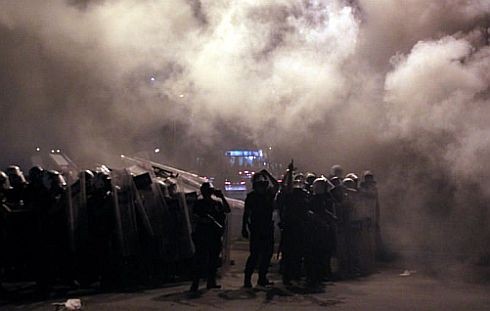Architects and Engineers Chambers Union of Turkey’s Chemical Engineers Chamber listed the hazardous effects of pepper gas, saying that pepper gas bombs and bullets used by police forces took part in chemical weapon category.
Architects and Engineers Chambers Union of Turkey’s (TMMOB) Chemical Engineers Chamber said that pepper gas bombs and bullets used by police forces took part in chemical weapon category.
A statement released by the chamber listed the hazardous effects of pepper gas on human life as follows:
“Lately, security forces utilized various tear and pepper gases to disperse people in public demonstrations. As TMMOB Chemical Engineers Chamber, we haven’t received a satisfactory response from the officials regarding these gasses even though we submitted a security information form (GBF).
“The chemical material used by security forces to intervene public demonstrations have several implications on health. These material are divided into three major categories: tearing, coughing and vomiting agents.
“Gas bombs, a type of chemical weapon, include 15 different chemical agents. Publicly known as pepper gas, these bombs fall into the “tearing” category. These gasses are “Chlorobenzylidenemalononitrile” (CS), Chloroacetophenone” (CN), “Dibenz (b,f)-1,4-oxazepine” (DM) and “Oleoresincapsicum” (OC).
“When we take a look at the gas bombs canister used in public demonstrations in Turkey, we observe that OC, CR and CS are generally used. According to Chemical Weapons Convention signed in 1993, these bombs fall into tear gas category and are considered as chemical weapons.
The convention strictly forbids the use of all chemical gasses including pepper gas to intervene public demonstrations.”
Life hazards
* Existing research points out that the lack of adequate research on the issue, however it still warned that these gasses should not be used under any circumstances.
* These gasses may cause life-threatening side effects in adults, which may occur several days after being exposed. Especially it may cause death among those who suffer from asthma or lung problems. In our country, such deaths have been documented.
* The impact of gas alters according to factors such as excessive use, inhaling indoors, height of gas particulars inhaled per minute, etc. It may also also cause inflammation and damage of the skin, eyes, and respiratory system. Starting in seconds after being exposed, these effect may last minutes to hours.
* Because the material is absorbed through the skin and spread to nerves, the side effects may last several hours. If the material is exposed excessively, if used indoors, if inhaled for long time, if individuals have high inhaling counts, the side effects are observed to be more severe.
* The gas material may also cause late health problems. If inhaled for long time and in high doses, the health risks are too severe and might cause deaths. The most severe side effects occur in the eyes, skin, digestive, blood and respiratory systems. Especially complications related to respiratory and blood systems may lead to deaths.
* Apart from these side effects, the material may also cause complications including nausea, vomiting, delirium, diarrhea, sensitivity to light, headache, agitation, confusion and panic.
* The side effects of pepper gas may be more severe among people who suffer from asthma, tuberculosis, hearth disease, undiagnosed aneurisms, weak immune system, as well as children, elders and pregnant.
* Therefore people with allergies, asthma, KOAH and related respiratory problems and heart disease are under immediate risk.
The chamber said that the use of OC and OS gas bombs and canisters violated Articles 5, 17 and 56 of the constitution, as well as Article 2 of European Declaration of Human Rights. It also added that the aforementioned weapons violated public meeting rights in Article 24 of the constitution, as well as Articles 10 and 11 of European Declaration of Human Rights. The chamber urged prosecutors to launch investigations on those who gave the orders and used these weapons. (EA/BM)
BIA News Desk
10 June 2013
Source: bianet.org




